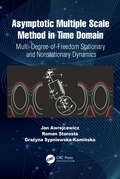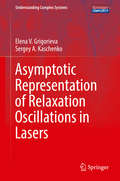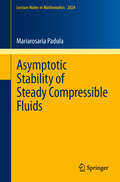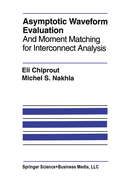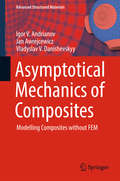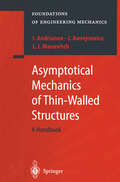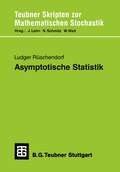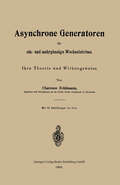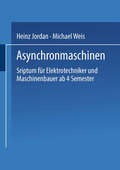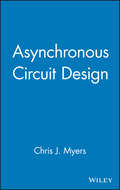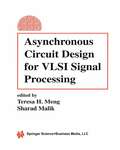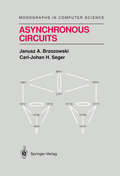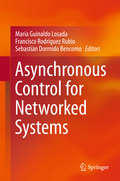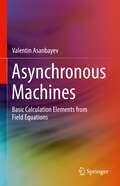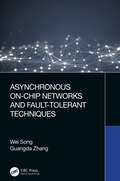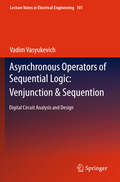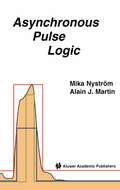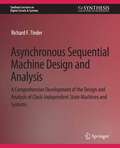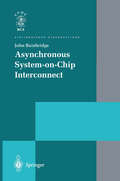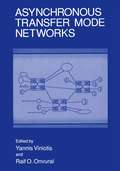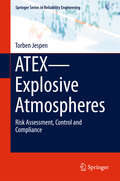- Table View
- List View
Asymptotic Multiple Scale Method in Time Domain: Multi-Degree-of-Freedom Stationary and Nonstationary Dynamics
by Jan Awrejcewicz Roman Starosta Grażyna Sypniewska-KamińskaThis book offers up novel research which uses analytical approaches to explore nonlinear features exhibited by various dynamic processes. Relevant to disciplines across engineering and physics, the asymptotic method combined with the multiple scale method is shown to be an efficient and intuitive way to approach mechanics. Beginning with new material on the development of cutting-edge asymptotic methods and multiple scale methods, the book introduces this method in time domain and provides examples of vibrations of systems. Clearly written throughout, it uses innovative graphics to exemplify complex concepts such as nonlinear stationary and nonstationary processes, various resonances and jump pull-in phenomena. It also demonstrates the simplification of problems through using mathematical modelling, by employing the use of limiting phase trajectories to quantify nonlinear phenomena. Particularly relevant to structural mechanics, in rods, cables, beams, plates and shells, as well as mechanical objects commonly found in everyday devices such as mobile phones and cameras, the book shows how each system is modelled, and how it behaves under various conditions. It will be of interest to engineers and professionals in mechanical engineering and structural engineering, alongside those interested in vibrations and dynamics. It will also be useful to those studying engineering maths and physics.
Asymptotic Multiple Scale Method in Time Domain: Multi-Degree-of-Freedom Stationary and Nonstationary Dynamics
by Jan Awrejcewicz Roman Starosta Grażyna Sypniewska-KamińskaThis book offers up novel research which uses analytical approaches to explore nonlinear features exhibited by various dynamic processes. Relevant to disciplines across engineering and physics, the asymptotic method combined with the multiple scale method is shown to be an efficient and intuitive way to approach mechanics. Beginning with new material on the development of cutting-edge asymptotic methods and multiple scale methods, the book introduces this method in time domain and provides examples of vibrations of systems. Clearly written throughout, it uses innovative graphics to exemplify complex concepts such as nonlinear stationary and nonstationary processes, various resonances and jump pull-in phenomena. It also demonstrates the simplification of problems through using mathematical modelling, by employing the use of limiting phase trajectories to quantify nonlinear phenomena. Particularly relevant to structural mechanics, in rods, cables, beams, plates and shells, as well as mechanical objects commonly found in everyday devices such as mobile phones and cameras, the book shows how each system is modelled, and how it behaves under various conditions. It will be of interest to engineers and professionals in mechanical engineering and structural engineering, alongside those interested in vibrations and dynamics. It will also be useful to those studying engineering maths and physics.
Asymptotic Representation of Relaxation Oscillations in Lasers (Understanding Complex Systems)
by Elena V. Grigorieva Sergey A. KaschenkoIn this book we analyze relaxation oscillations in models of lasers with nonlinear elements controlling light dynamics. The models are based on rate equations taking into account periodic modulation of parameters, optoelectronic delayed feedback, mutual coupling between lasers, intermodal interaction and other factors. With the aim to study relaxation oscillations we present the special asymptotic method of integration for ordinary differential equations and differential-difference equations. As a result, they are reduced to discrete maps. Analyzing the maps we describe analytically such nonlinear phenomena in lasers as multistability of large-amplitude relaxation cycles, bifurcations of cycles, controlled switching of regimes, phase synchronization in an ensemble of coupled systems and others. The book can be fruitful for students and technicians in nonlinear laser dynamics and in differential equations.
Asymptotic Stability of Steady Compressible Fluids (Lecture Notes in Mathematics #2024)
by Mariarosaria PadulaThis volume introduces a systematic approach to the solution of some mathematical problems that arise in the study of the hyperbolic-parabolic systems of equations that govern the motions of thermodynamic fluids. It is intended for a wide audience of theoretical and applied mathematicians with an interest in compressible flow, capillarity theory, and control theory. The focus is particularly on recent results concerning nonlinear asymptotic stability, which are independent of assumptions about the smallness of the initial data. Of particular interest is the loss of control that sometimes results when steady flows of compressible fluids are upset by large disturbances. The main ideas are illustrated in the context of three different physical problems: (i) A barotropic viscous gas in a fixed domain with compact boundary. The domain may be either an exterior domain or a bounded domain, and the boundary may be either impermeable or porous. (ii) An isothermal viscous gas in a domain with free boundaries. (iii) A heat-conducting, viscous polytropic gas.
Asymptotic Waveform Evaluation: And Moment Matching for Interconnect Analysis (The Springer International Series in Engineering and Computer Science #252)
by Eli Chiprout Michel S. NakhlaThe intense drive for signal integrity has been at the forefront ofrapid and new developments in CAD algorithms. Thousands ofengineers, intent on achieving the best design possible, use SPICE on a daily basis for analog simulation and general circuit analysis. But the strained demand for high data speeds, coupled with miniaturizationon an unprecedented scale, has highlighted the previously negligible effects of interconnects; effects which are not always handled appro priately by the present levels of SPICE. Signals at these higher speeds may be degraded by long interconnect lengths compared to the increasingly shorter sig nal rise times. Interconnect structures can be diverse (pins, connectors, leads, microstrips, striplines, etc. ) and present at any of the hierarchical packaging levels: integrated circuits, printed circuit boards, multi-chip modules or sys tem backplanes. Analysis of these effects in any CAD package has become a necessity. Asymptotic waveform evaluation (AWE) and other moment matching tech niques have recently proven useful in the analysis of interconnect structures and various networks containing large linear structures with nonlinear termi nations. Previously, all that was available to the designer was a full SPICE simulation or a quick but uncertain timing estimation. Moment matching, used in linear systems analysis as a method of model reduction, describes a method to extract a small set of dominant poles from a large network. The information is obtained from the Taylor series coefficients (moments) of that system.
Asymptotical Mechanics of Composites: Modelling Composites without FEM (Advanced Structured Materials #77)
by Igor V. Andrianov Jan Awrejcewicz Vladyslav V. DanishevskyyIn this book the authors show that it is possible to construct efficient computationally oriented models of multi-parameter complex systems by using asymptotic methods, which can, owing to their simplicity, be directly used for controlling processes arising in connection with composite material systems. The book focuses on this asymptotic-modeling-based approach because it allows us to define the most important out of numerous parameters describing the system, or, in other words, the asymptotic methods allow us to estimate the sensitivity of the system parameters. Further, the book addresses the construction of nonlocal and higher-order homogenized models. Local fields on the micro-level and the influence of so-called non-ideal contact between the matrix and inclusions are modeled and investigated. The book then studies composites with non-regular structure and cluster type composite conductivity, and analyzes edge effects in fiber composite materials. Transition of load from a fiber to a matrix for elastic and viscoelastic composites, various types of fiber composite fractures, and buckling of fibers in fiber-reinforced composites is also investigated. Last but not least, the book includes studies on perforated membranes, plates, and shells, as well as the asymptotic modeling of imperfect nonlinear interfaces.
Asymptotical Mechanics of Thin-Walled Structures (Foundations of Engineering Mechanics)
by Igor V. Andrianov Jan Awrejcewicz Leonid I. ManevitchIn this book a detailed and systematic treatment of asymptotic methods in the theory of plates and shells is presented. The main features of the book are the basic principles of asymptotics and their applications, traditional approaches such as regular and singular perturbations, as well as new approaches such as the composite equations approach. The book introduces the reader to the field of asymptotic simplification of the problems of the theory of plates and shells and will be useful as a handbook of methods of asymptotic integration. Providing a state-of-the-art review of asymptotic applications, this book will be useful as an introduction to the field for novices as well as a reference book for specialists.
Asynchrone Generatoren für ein- und mehrphasige Wechselströme: Ihre Theorie und Wirkungsweise
by Clarence Paul FeldmannAsynchronmaschinen: Sriptum für Elektrotechniker und Maschinenbauer ab 4. Semester
by Heinz Jordan Michael WeisAsynchronous Circuit Design
by Chris J. MyersWith asynchronous circuit design becoming a powerful tool in the development of new digital systems, circuit designers are expected to have asynchronous design skills and be able to leverage them to reduce power consumption and increase system speed. This book walks readers through all of the different methodologies of asynchronous circuit design, emphasizing practical techniques and real-world applications instead of theoretical simulation. The only guide of its kind, it also features an ftp site complete with support materials. Market: Electrical Engineers, Computer Scientists, Device Designers, and Developers in industry.
Asynchronous Circuit Design for VLSI Signal Processing
by Teresa H. Meng Sharad MalikAsynchronous Circuit Design for VLSI Signal Processing is a collection of research papers on recent advances in the area of specification, design and analysis of asynchronous circuits and systems. This interest in designing digital computing systems without a global clock is prompted by the ever growing difficulty in adopting global synchronization as the only efficient means to system timing. Asynchronous circuits and systems have long held interest for circuit designers and researchers alike because of the inherent challenge involved in designing these circuits, as well as developing design techniques for them. The frontier research in this area can be traced back to Huffman's publications `The Synthesis of Sequential Switching Circuits' in 1954 followed by Unger's book, `Asynchronous Sequential Switching Circuits' in 1969 where a theoretical foundation for handling logic hazards was established. In the last few years a growing number of researchers have joined force in unveiling the mystery of designing correct asynchronous circuits, and better yet, have produced several alternatives in automatic synthesis and verification of such circuits. This collection of research papers represents a balanced view of current research efforts in the design, synthesis and verification of asynchronous systems.
Asynchronous Circuits (Monographs in Computer Science)
by Janusz A. Brzozowski Carl-Johan H. SegerIn recent years, there has been a great surge of interest in asynchronous circuits, largely through the development of new asynchronous design methodologies. This book provides a comprehensive theory of asynchronous circuits, including modelling, analysis, simulation, specification, verification, and an introduction to their design.
Asynchronous Control for Networked Systems
by María Guinaldo Losada Francisco Rodríguez Rubio Sebastián Dormido BencomoThis book sheds light on networked control systems; it describes different techniques for asynchronous control, moving away from the periodic actions of classical control, replacing them with state-based decisions and reducing the frequency with which communication between subsystems is required. The text focuses specially on event-based control.Split into two parts, Asynchronous Control for Networked Systems begins by addressing the problems of single-loop networked control systems, laying out various solutions which include two alternative model-based control schemes (anticipatory and predictive) and the use of H2/H∞ robust control to deal with network delays and packet losses. Results on self-triggering and send-on-delta sampling are presented to reduce the need for feedback in the loop. In Part II, the authors present solutions for distributed estimation and control. They deal first with reliable networks and then extend their results to scenarios in which delays and packet losses may occur.The novel results presented in Asynchronous Control for Networked Systems are transmitted in a concise and clear style supported by simulation and experimental examples. Some applications are also provided.Academic researchers and graduate students investigating control theory, control engineering and computer communications systems can use this monograph to learn how asynchronous control helps tackle the problems of networked systems in centralized and distributed schemes. Control practitioners at work in power systems, vehicle coordination and traffic networks will also find this book helpful in improving the performance of their systems.
Asynchronous Machines: Basic Calculation Elements from Field Equations
by Valentin AsanbayevThis book attempts to eliminate the existing “imbalance” between the theory of electric machines and the theory of electromagnetic fields. In order to develop viable methods for engineering calculations, the author applies field equations. The resulting, new methods consist of traditional calculation elements represented in a refined form (circuit-loops, parameters, equivalent circuits and voltage equations). These calculation methods should be effective both for researchers and engineering practitioners, especially, in relation to the modern electric machines, such as powerful turbine generators, large high-speed synchronous motors, etc.
Asynchronous On-Chip Networks and Fault-Tolerant Techniques
by Wei Song Guangda ZhangAsynchronous On-Chip Networks and Fault-Tolerant Techniques is the first comprehensive study of fault-tolerance and fault-caused deadlock effects in asynchronous on-chip networks, aiming to overcome these drawbacks and ensure greater reliability of applications. As a promising alternative to the widely used synchronous on-chip networks for multicore processors, asynchronous on-chip networks can be vulnerable to faults even if they can deliver the same performance with much lower energy and area compared with their synchronous counterparts – faults can not only corrupt data transmission but also cause a unique type of deadlock. By adopting a new redundant code along with a dynamic fault detection and recovery scheme, the authors demonstrate that asynchronous on-chip networks can be efficiently hardened to tolerate both transient and permanent faults and overcome fault-caused deadlocks. This book will serve as an essential guide for researchers and students studying interconnection networks, fault-tolerant computing, asynchronous system design, circuit design and on-chip networking, as well as for professionals interested in designing fault-tolerant and high-throughput asynchronous circuits.
Asynchronous On-Chip Networks and Fault-Tolerant Techniques
by Wei Song Guangda ZhangAsynchronous On-Chip Networks and Fault-Tolerant Techniques is the first comprehensive study of fault-tolerance and fault-caused deadlock effects in asynchronous on-chip networks, aiming to overcome these drawbacks and ensure greater reliability of applications. As a promising alternative to the widely used synchronous on-chip networks for multicore processors, asynchronous on-chip networks can be vulnerable to faults even if they can deliver the same performance with much lower energy and area compared with their synchronous counterparts – faults can not only corrupt data transmission but also cause a unique type of deadlock. By adopting a new redundant code along with a dynamic fault detection and recovery scheme, the authors demonstrate that asynchronous on-chip networks can be efficiently hardened to tolerate both transient and permanent faults and overcome fault-caused deadlocks. This book will serve as an essential guide for researchers and students studying interconnection networks, fault-tolerant computing, asynchronous system design, circuit design and on-chip networking, as well as for professionals interested in designing fault-tolerant and high-throughput asynchronous circuits.
Asynchronous Operators of Sequential Logic: Digital Circuit Analysis and Design (Lecture Notes in Electrical Engineering #101)
by Vadim VasyukevichThis book is dedicated to new mathematical instruments assigned for logical modeling of the memory of digital devices. The case in point is logic-dynamical operation named venjunction and venjunctive function as well as sequention and sequentional function. Venjunction and sequention operate within the framework of sequential logic. In a form of the corresponding equations, they organically fit analytical expressions of Boolean algebra. Thus, a sort of symbiosis is formed using elements of asynchronous sequential logic on the one hand and combinational logic on the other hand. So, asynchronous logic is represented in the form of enhanced Boolean logic. The book contains initial concepts, fundamental definitions, statements, principles and rules needed for theoretical justification of the mathematical apparatus and its validity for asynchronous logic. Asynchronous operators named venjunctor and sequentor are designed for practical implementation. These basic elements are assigned for realizing of memory functions in sequential circuits. Present research work is the final stage of generalization and systematization of all those ideas and investigations, author’s interest to which alternately flashed up and faded over many years and for various reasons until formed “critical mass”, and all findings were arranged definitively as a mathematical basis of a theory appropriately associated under a common theme – asynchronous sequential logic, essentially classified as switching logic, which falls into category of algebraic logics.
Asynchronous Pulse Logic
by Mika M. Nystrom Alain MartinThis comprehensive analysis of a newly developed asynchronous circuit family covers circuit theory, practical circuits, design tools and an example of the design of a simple asynchronous microprocessor using the circuit family.
Asynchronous Sequential Machine Design and Analysis: A Comprehensive Development of the Design and Analysis of Clock-Independent State Machines and Systems (Synthesis Lectures on Digital Circuits & Systems)
by Richard TinderAsynchronous Sequential Machine Design and Analysis provides a lucid, in-depth treatment of asynchronous state machine design and analysis presented in two parts: Part I on the background fundamentals related to asynchronous sequential logic circuits generally, and Part II on self-timed systems, high-performance asynchronous programmable sequencers, and arbiters. Part I provides a detailed review of the background fundamentals for the design and analysis of asynchronous finite state machines (FSMs). Included are the basic models, use of fully documented state diagrams, and the design and characteristics of basic memory cells and Muller C-elements. Simple FSMs using C-elements illustrate the design process. The detection and elimination of timing defects in asynchronous FSMs are covered in detail. This is followed by the array algebraic approach to the design of single-transition-time machines and use of CAD software for that purpose, one-hot asynchronous FSMs, and pulse mode FSMs. Part I concludes with the analysis procedures for asynchronous state machines. Part II is concerned mainly with self-timed systems, programmable sequencers, and arbiters. It begins with a detailed treatment of externally asynchronous/internally clocked (or pausable) systems that are delay-insensitive and metastability-hardened. This is followed by defect-free cascadable asynchronous sequencers, and defect-free one-hot asynchronous programmable sequencers--their characteristics, design, and applications. Part II concludes with arbiter modules of various types, those with and without metastability protection, together with applications. Presented in the appendices are brief reviews covering mixed-logic gate symbology, Boolean algebra, and entered-variable K-map minimization. End-of-chapter problems and a glossary of terms, expressions, and abbreviations contribute to the reader's learning experience. Five productivity tools are made available specifically for use with this text and briefly discussed in the Preface. Table of Contents: I: Background Fundamentals for Design and Analysis of Asynchronous State Machines / Introduction and Background / Simple FSM Design and Initialization / Detection and Elimination of Timing Defects in Asynchronous FSMs / Design of Single Transition Time Machines / Design of One-Hot Asynchronous FSMs / Design of Pulse Mode FSMs / Analysis of Asynchronous FSMs / II: Self-Timed Systems/ Programmable Sequencers, and Arbiters / Externally Asynchronous/Internally Clocked Systems / Cascadable Asynchronous Programmable Sequencers (CAPS) and Time-Shared System Design / Asynchronous One-Hot Programmable Sequencer Systems / Arbiter Modules
Asynchronous System-on-Chip Interconnect (Distinguished Dissertations)
by John BainbridgeAsynchronous System-on-Chip Interconnect describes the use of an entirely asynchronous system-bus for the modular construction of integrated circuits. Industry is just awakening to the benefits of asynchronous design in avoiding the problems of clock-skew and multiple clock-domains, an din parallel with this is coming to grips with Intellectual Property (IP) based design flows which emphasise the need for a flexible interconnect strategy. In this book, John Bainbridge investigates the design of an asynchronous on-chip interconnect, looking at all the stages of the design from the choice of wiring layout, through asynchronous signalling protocols to the higher level problems involved in supporting split transactions. The MARBLE bus (the first asynchronous SoC bus) used in a commercial demonstrator chip containing a mixture of asynchronous and synchronous macrocells is used as a concrete example throughout the book.
Asynchronous Transfer Mode Networks
by Yannis Viniotis Raif O. OnvuralBroadband Integrated Services Digital Network (B-ISDN) is conceived as an all-purpose digital network supporting interactive and distributive services, bursty and continuous traffic, connection-oriented and connectionless services, all in the same network. The concepts of ISDN in general and B-ISDN in particular have been evolving since CCIIT adopted the rrrst set ofISDN recommendations in 1984. Thirteen recommendations outlining the fundamental principles and initial specifications for B-ISDN were approved in 1990, with Asynchronous Transfer Mode (ATM) being the transfer mode of choice for B-ISDN. It seems fair to say that B-ISDN concepts have changed the face of networking. The expertise we have developed for a century on telephone systems and over a number of decades on packet networks is proving to be insufficient to deploy and operate the envisioned B-ISDNs. Much more needs to be understood and satisfactorily addressed before ATM networks can become a reality. Tricomm'93 is dedicated to A TM networks. The technical program consists of invited papers addressing a large subset of issues of practical importance in the deployment of ATM networks. This is the sixth in a series of Research Triangle Conferences on Computer Communications, which emerged through the efforts of the local chapter of IEEE Communications Society.
At Home in Space: The Late Seventies into the Eighties (Springer Praxis Books)
by Ben EvansThis volume, like the others, not only focuses upon the individual missions within the decade but also upon key challenges facing human space exploration at specific points within those years - from the problems of simply breathing and eating in space to the challenges of venturing outside in a pressurized spacesuit, the development of newer and better space toilets, and the difficulties of locomotion on the Moon. The Eighties was a time when traveling into space far more commonplace. Examining in detail the American and Soviet fronts, Ben Evans gives a comprehensive analysis of the varying fortunes of the U.S. space shuttle in the Eighties, including its early test flights and commercial flights, its problems, the 51L tragedy and its aftermath, and the resumption of operations with STS-26. The U.S. story ends with STS-37 in April 1991. In the Soviet sphere, two pivotal space station efforts - Salyut 7 and its succesor, Mir - are considered, showing how they were alike and different.
At One with Nature: Advances in Ecological Architecture in the Work of Ken Yeang
by Ken Yeang Edwina Threipland"At One with Nature is an inspiring collection of the latest work of Ken Yeang that further advances sustainable architecture and design. This collection features recent projects as he explores how we can achieve harmony between the natural and our built environments to create a better planet by design. Each project features and highlights not only the systems and devices adopted, but also outlines the intentions and ecological considerations demonstrating best practices for how we can proceed moving forward. The book role models our living Earth and shows how we can behave as stewards of our planet."--Cassia Patel, Oceanic Global Foundation At One with Nature showcases Ken Yeang's latest ideas, built projects designs, research work and advances in the field of designing with nature, a topic that Yeang has pioneered and developed over many decades since receiving his doctorate in ecological design and planning from Cambridge University. His ideas and work are even more pertinent today with the current state of devastation of Earth's natural systems and a biogeochemical cycle that has been extensively and severely impacted by human society. The global environment today is in a state of crisis, but what can society do to address the issues? Yeang's recent projects are presented with instructive diagrams that provide a basis for action for architects, planners, designers, engineers, and anyone whose daily work impinges on the natural environment. Offered in a highly visual, annotated format, with instructive illustrations of Yeang's theoretical books on the topic, At One with Nature is an invaluable resource that students and academics interested in designing with nature will find both informative and relevant.
ATEX—Explosive Atmospheres: Risk Assessment, Control and Compliance (Springer Series in Reliability Engineering)
by Torben JespenThis book details how safety (i.e. the absence of unacceptable risks) is ensured in areas where potentially explosive atmospheres (ATEX) can arise. The book also offers readers essential information on how to comply with the newest (April 2016) EU legislation when the presence of ATEX cannot be avoided. By presenting general guidance on issues arising out of the EU ATEX legislation – especially on zone classification, explosion risk assessment, equipment categorization, Ex-marking and related technical/chemical aspects – the book provides equipment manufacturers, responsible employers, and others with the essential knowledge they need to be able to understand the different – and often complicated – aspects of ATEX and to implement the necessary safety precautions. As such, it represents a valuable resource for all those concerned with maintaining high levels of safety in ATEX environments.
